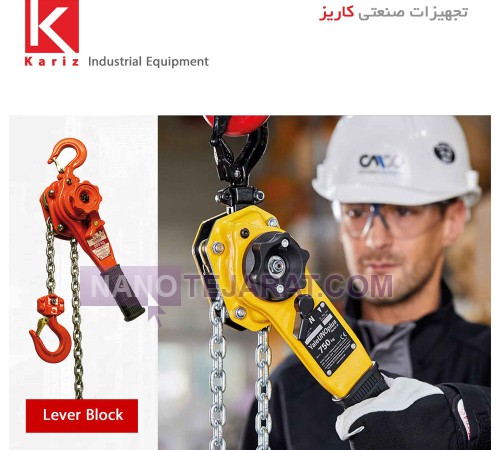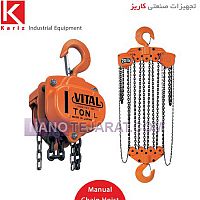
Viewed : 44641
- Tel
- 021-55400161
- | Cell
- 09126645202


| ,Importer,,Wholesaler,Retailer | |
| Tehran | |
| 021-55400161 | |
| kariz_ie | |
| info@karizie.com | |
Import and distribution of chain polyphs made in Japan, Germany, Korea and China in Kariz industrial equipment.
Chain polylift for sale
Selling manual polylift
Selling polylift 800 kilos
Sale of polylift 1.6 tons
Sale of polylift 3.2 tons
Sale of polylift 6.3 tons
Polylifts are a device designed to pull the load on the surface and lift it at different angles. The resulting force for this operation is created through hand force and causes the load to move through the handle installed on the puller to the steel chain through which the tensile force is transferred to the load. Polylifts are available in common tonnages of 0.8 tons - 1.6 tons - 3.2 tons - 6.3 tons.
In polylifts, steel chains with G80 steel grade are used, which have a high percentage of carbon and have high surface hardness and wear. Therefore, the service life of the chain polylift is higher than that of the towed polylifts. In the production of polylift connecting chain, which has a minimum tensile strength of 550 N/mm2, thermal hardening is used to provide high tension and security in the connection.
The lifting industry has witnessed significant advancements over the years, with various tools and equipment being developed to enhance efficiency and safety. Among these innovations, the lever block stands out as a game-changer. This essay explores the lever blocks history, design, applications, advantages, and impact on the lifting industry.
1. Historical Background:
The concept of using levers for lifting dates back to ancient times. However, it was not until the 19th century that modern lever blocks began to emerge. The initial designs were simple and lacked sophistication. Over time, engineers refined these devices to meet the growing demands of industries such as construction, manufacturing, and logistics.
2. Design and Components:
A lever block consists of several key components that work together to facilitate lifting operations. The main parts include a load chain or wire rope, a hand-operated lever mechanism, gears or pulleys for mechanical advantage, and hooks or attachments for securing loads. These components are carefully engineered to ensure durability, reliability, and ease of use.
3. Applications:
Lever blocks find extensive applications across various industries due to their versatility and adaptability. They are commonly used in construction sites for hoisting heavy materials during building erection or renovation projects. Additionally, they play a crucial role in manufacturing facilities by assisting in assembly line operations and moving heavy machinery. Moreover, lever blocks are indispensable in logistics operations for loading/unloading cargo from trucks or ships.
4. Advantages of Lever Blocks:
4.1 Increased Efficiency: Lever blocks provide mechanical advantage through their gear or pulley systems, enabling users to lift heavy loads with minimal effort.
4.2 Portability: Lever blocks are compact and lightweight compared to other lifting equipment options like cranes or forklifts.
4.3 Versatility: These devices can be used in various environments due to their adaptability to different load capacities and working conditions.
4.4 Safety: Lever blocks are designed with safety features such as load limiters, anti-reversing mechanisms, and robust hooks to prevent accidents and ensure secure lifting operations.
4.5 Cost-Effectiveness: Lever blocks offer a cost-effective solution for lifting tasks, reducing the need for expensive machinery or additional labor.
5. Impact on the Lifting Industry:
The introduction of lever blocks has revolutionized the lifting industry in several ways:
5.1 Increased Productivity: Lever blocks enable workers to complete lifting tasks more efficiently, reducing project timelines and increasing overall productivity.
5.2 Enhanced Safety Standards: The safety features incorporated into lever blocks have significantly reduced workplace accidents related to lifting operations, ensuring a safer working environment.
5.3 Cost Savings: Lever blocks provide a cost-effective alternative to heavy machinery, allowing businesses to save on equipment costs while maintaining high operational standards.
5.4 Improved Ergonomics: By minimizing physical strain on workers during lifting operations, lever blocks contribute to improved ergonomics and reduced risk of injuries.
Conclusion:
The lever block has emerged as an indispensable tool in the lifting industry due to its efficiency, versatility, safety features, and cost-effectiveness. Its impact on various sectors such as construction, manufacturing, and logistics cannot be overstated. As technology continues to advance, it is expected that lever block designs will evolve further to meet the ever-growing demands of modern industries while prioritizing safety and efficiency in lifting operations.
WEBSITE: Lever Block Iran

 Manual Chain Hoist
Manual Chain Hoist